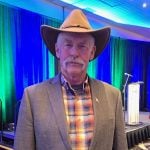Wetland makeover | Ducks Unlimited reclaims almost one million acres southeast of Edmonton
DAYSLAND, Alta. — In 1953, Peter Gabruck drained a few potholes and cleared some trees to make it easier to farm his land.
Today, Ducks Unlimited Canada has bought the land and started the process of flooding it to bring back the potholes and trees.
Like other farmers, Gabruck has drained sloughs and knocked down trees over the past 50 years.
“We did quite a bit of breaking and there was quite a few sloughs and potholes that needed to be drained,” he said during a Ducks Unlimited event to show off the restoration project on three farms north of Daysland.
Read Also

Chinese, Indian tariffs take toll on pea prices
The disruption of pea exports from Canada’s largest customers will likely result in slow pea exports for the remainder of the crop year.
“You had to farm more and more land to make a living.”
Restoring the 314-acre parcel of land to close to its original state is part of Ducks Unlimited’s new Legacy Wetland Restoration Program.
The organization used a $1 million donation from Agrium to buy five quarters of land north of Daysland. Ducks Unlimited staff restored the land to its original state, added a conservation easement and then resold the land, using the money for more restoration projects.
For Ducks Unlimited, the land southeast of Edmonton is a key priority area for restoration. The almost one million acre area straddles two major watersheds: the Vermilion River and the Battle River. The area was originally native prairie with trees and potholes, and most of it has been converted to crop and pasture land.
Pascal Badiou, a research scientist with Ducks Unlimited, said wetlands are disappearing at an alarming rate.
About six percent of the world’s land surface is covered by wetlands, of which 50 percent has been lost over the last century.
“It’s a tremendous amount of loss globally. A lot of people think that loss is historic,” said Badiou.
It may not seem like draining a few sloughs would have a negative impact, but Badiou said sloughs and wetlands are invaluable.
Wetlands store flood water, act as a buffer against drought, help mitigate against large storms by slowing down the water and help purify contaminants that run from the land to water.
Badiou said other Ducks Unlimited work has shown that wetlands dramatically reduce phosphorus and nitrogen runoff from fields to streams.
“Wetland loss is having a dramatic effect on water quality and quantity across Canadian prairies,” he said.
Ducks Unlimited’s goal through its Legacy Wetland Restoration Program is to conserve more than 2,000 wetland basins and 24,000 acres of upland habit in the Daysland area over the next five years.
It didn’t take much convincing for Marianne and Werner Strohhaeker to sell their land to Ducks Unlimited for the restoration program.
The land was divided into small 40-acre parcels because of sloughs and the Holden Drainage District ditches, a series of ditches crisscrossing thousands of acres of farmland.
“It was poor land,” said Werner.
“Who wants to farm 40 acre pieces with a 60 foot air seeder.… I thought it would be better used for the ducks, geese and coyotes.”
Grain land was seeded to pasture and the drainage ditches plugged. Sloughs have already started to fill and water fowl are building their nests at the edge of the water.
“A lot of land has been drained and the bush taken out. This is the opposite, and it feels good,” he said.
“I feel it’s a good project.”
Bev and Duane Ronsko sold three quarter sections to Ducks Unlimited. A busy trailer business didn’t give them enough time to farm the marginal land.
“This is a good way to pass on the land to others to use for future generations,” said Duane, who admits to draining sloughs and clearing trees to help make the farm more viable.














